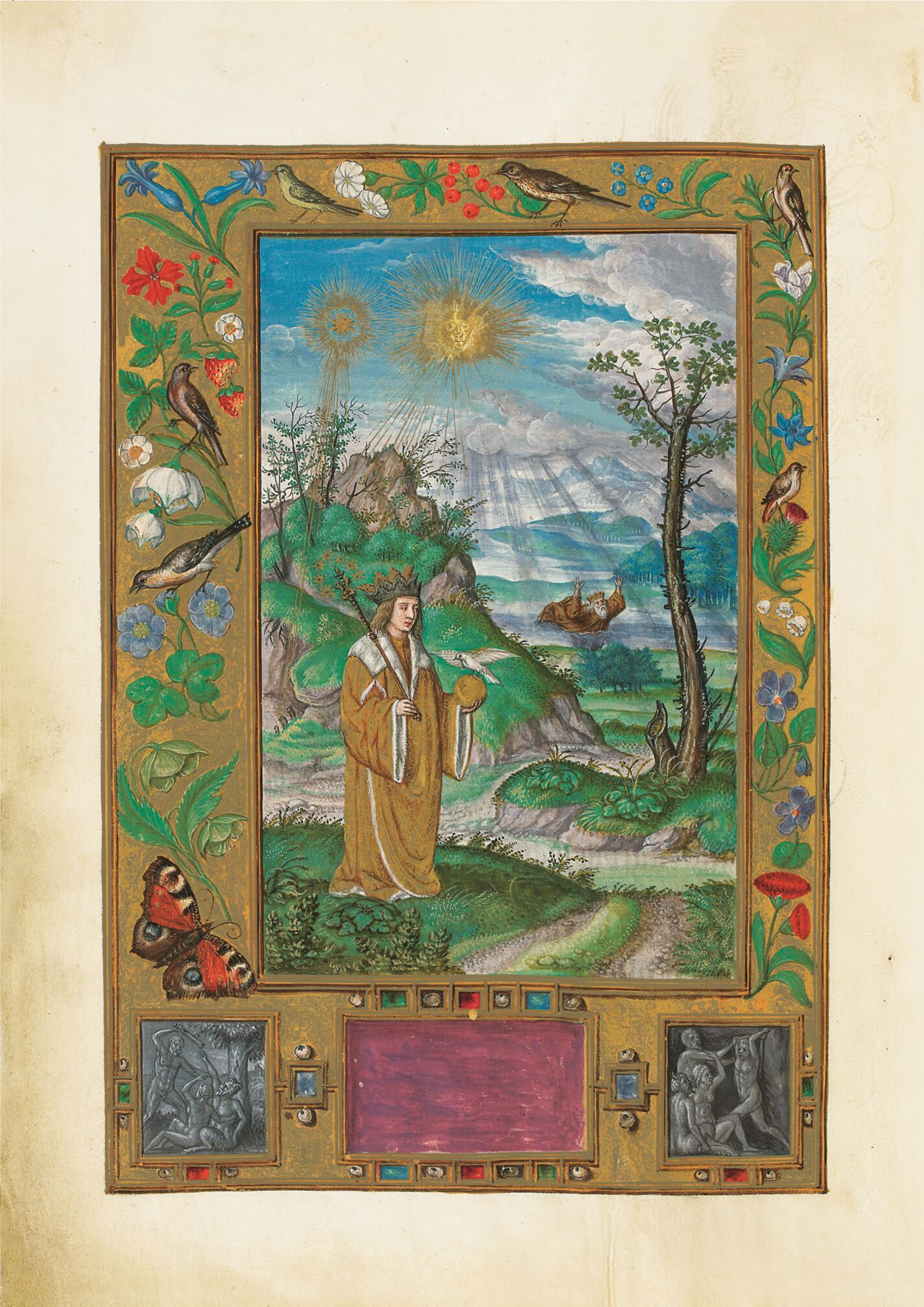A magnificently dressed king with a youthful face stands in the left foreground of this miniature. The golden coat with a light-coloured fur collar and fur trimming on its wide sleeves is still much too big for the young ruler. His royal insignias also seem disproportionately large: he holds a golden apple in his left hand, on top of which a white dove with shimmering golden wings is perched; in his right hand he holds a long sceptre which rests against his shoulder, seven stars circling around its tip; on his head, as the text confirms, he wears a triple crown of gold, silver and iron. The mountainous landscape around him offers views of the swamp- and waterlands. Half submerged in the dark quagmire is an elderly king. His hair and beard are grey; his garments and crown are gold. The hands of the drowning king are raised in despair to the heavens. There his dramatic death is echoed by the dense dark clouds and showers of rain erupting from within, whereas the skies above the young king, who has the sun and morning star shining down upon him, are calm and deep blue.
The main miniature is framed by a floral margin. In the plinth area down below, there is a purple panel inserted between two other panels in grisaille to the left and right. Both of these panels depict battle scenes involving goat-legged creatures. On the left is the scene in which Cain kills Abel, painted after the 1524 engraving by Lucas van Leyden, and on the right is Hercules, painted after an engraving by Albrecht Dürer.
This miniature illustrates the ancient myth of death and rebirth, salvation and reincarnation. In accordance with the allegory of “dying and becoming”, it is of central importance to alchemy. In the passage of the text in the Splendor Solis relating to this particular image, this idea is mentioned in conjunction with Aristotle, a philosopher both highly regarded and frequently consulted by alchemists. In the context of the laboratory, the image of the drowning elderly king represents the operation of solution, the dissolving of matter in strong “mercurial” liquids. The theme of the main miniature is echoed by the two framing scenes depicting the killing of Abel and the battle of Hercules. As a matter of fact, the luminary Eirenaeus Philalethes even ascribed Hercules a kind of patronage over alchemy which consisted in the restoration of unity by virtue of connecting disparate particles, as Ethan Allen Hitchcock notes. By including the sub-scene of Hercules’ struggle, might the painter of the Splendor Solis have aspired to a similar significance for his miniature?
Jörg Völlnagel
(Art historian, research associate at the Staatliche Museen zu Berlin)

A magnificently dressed king with a youthful face stands in the left foreground of this miniature. The golden coat with a light-coloured fur collar and fur trimming on its wide sleeves is still much too big for the young ruler. His royal insignias also seem disproportionately large: he holds a golden apple in his left hand, on top of which a white dove with shimmering golden wings is perched; in his right hand he holds a long sceptre which rests against his shoulder, seven stars circling around its tip; on his head, as the text confirms, he wears a triple crown of gold, silver and iron. The mountainous landscape around him offers views of the swamp- and waterlands. Half submerged in the dark quagmire is an elderly king. His hair and beard are grey; his garments and crown are gold. The hands of the drowning king are raised in despair to the heavens. There his dramatic death is echoed by the dense dark clouds and showers of rain erupting from within, whereas the skies above the young king, who has the sun and morning star shining down upon him, are calm and deep blue.
The main miniature is framed by a floral margin. In the plinth area down below, there is a purple panel inserted between two other panels in grisaille to the left and right. Both of these panels depict battle scenes involving goat-legged creatures. On the left is the scene in which Cain kills Abel, painted after the 1524 engraving by Lucas van Leyden, and on the right is Hercules, painted after an engraving by Albrecht Dürer.
This miniature illustrates the ancient myth of death and rebirth, salvation and reincarnation. In accordance with the allegory of “dying and becoming”, it is of central importance to alchemy. In the passage of the text in the Splendor Solis relating to this particular image, this idea is mentioned in conjunction with Aristotle, a philosopher both highly regarded and frequently consulted by alchemists. In the context of the laboratory, the image of the drowning elderly king represents the operation of solution, the dissolving of matter in strong “mercurial” liquids. The theme of the main miniature is echoed by the two framing scenes depicting the killing of Abel and the battle of Hercules. As a matter of fact, the luminary Eirenaeus Philalethes even ascribed Hercules a kind of patronage over alchemy which consisted in the restoration of unity by virtue of connecting disparate particles, as Ethan Allen Hitchcock notes. By including the sub-scene of Hercules’ struggle, might the painter of the Splendor Solis have aspired to a similar significance for his miniature?
Jörg Völlnagel
(Art historian, research associate at the Staatliche Museen zu Berlin)